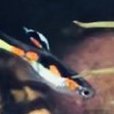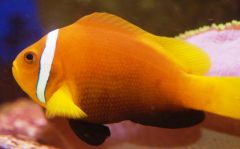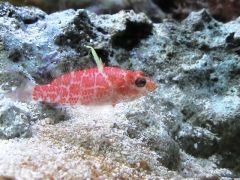-
Posts
1,462 -
Joined
-
Last visited
Content Type
Profiles
Forums
Gallery
Events
Store
Everything posted by traveller7
-
I think BRK has quite a selection, but your local pool supply store should have a nice selection
-
Running an ETSS here, it sure skims, but on my dirty overfed fish filled extravaganza....it needs to be cleaned once a week or more; and it is a pita to clean.
-
You could always buy a pump in the class you really want and use a bypass line to reduce flow if the pump is too big Maybe even mod it in a recirculating fashion, or... :D
-
Then a unit with more air, more water, and greater "contact space" is going to be required. I don't recall the Hurricane being that much more powerful.....of course I am getting old.
-
IME: about the same. Not sure I understand the "did great at first but not now." Does it still pull out gunk? If not, why?
-
-
-
Geometric pygmy hawk, Plectranthias inermis: Or Cujo the A. nigripes:
-
Most species in that family/genus stay quite small. I'd wager, they have not raised many/any.
-
The maximum appears to be less then 72 days, most aquaculture folks go 6 weeks. I tend to follow the folks that measure success financially, so stay on track for the full 6 weeks minimum.
-
Anemonia majano, aka a pest anemone. Look like mini Bubble Tipped Anemones, eat well, divide well, live through about anything.
-
Here is the nice coldy thread to go with the Waratah biotoper effort: http://reefcentral.com/forums/showthread.p...threadid=890751
-
Glad you found him in time to give him a shot at recovery. Good luck to both of you
-
Mithrax sculptus. Commonly found with a 2cm to 3cm shell. Rumored to 10cm. As it gets larger, don't hesitate to target feed it so it does not pursue fish, etc.
-
Please skip the Magnifica in a small space, a healthy one will outgrow that tank within months. A sick one will make quite a mess of it. Odds of the latter are extremely high. Not to mention, the BTAs are always in demand and you will recoup your investment this year.
-
Depending on the type of bulb and ballast, you are looking at the extremes: such as fire, bulb exploding, etc. There is some flexibility between starting circuits, but even the ballasts that are supposed to run 150/175 have been problematic. It is recommended to stick with matching bulb + ballast types on almost all occassions. Post the ballast type, folks may even have bulbs lying around
-
Operative words, "so far," yes You'll know you are at the next stage when one doubles in size and the other gets to work biting the rocks instead of running away when "he" is chased That may take 6-9 months in the Clarkii complex. Cheers.
-
With the right pair of clowns, an RBTA will be safe from almost any predator. IME mature: skunks, nigripes, and black ocellaris have proven very effective pound for pound.
-

Pairing clowns question.
traveller7 replied to jason the filter freak's topic in Propagation and Breeding
Wow. - age of a clown is very difficult to determine because under certain conditions they may remain juveniles indefinitely. My oldest A. ocellaris has been a juvenile since the 90's. There have been numerous juveniles introduced, but they have always become dominant. - take 2 juveniles, isolate, feed, protect, and most species will mature into Female/Male pairs. Space can be an issue; in a space that is too small...expect the female/dominant specimen to kill/chase the other out of the tank. Strongly pair bonded specimens will occasionally tolerate cramped spaces. - some species will tolerate "colony life" better then others and have a Female, at least 1 male, and a bunch of juveniles. Make sure space and shelter are available and feed heavily. - clowns have typically shown little complaint about pairing with brothers or sisters. Most breeders try to avoid such pairings, but sometimes you have no choice. - anemones are not necessary to trigger pair bonds, but a safe environment helps considerably. - getting a pair to begin breeding is quite a different procedure from bonding and will typically require a period of conditioning. - at least one species has been documented to begin breeding within 1yr of hatching. -
The odds of finding a "mature Male" to pair are far too small and very high risk of getting one moving toward female already. Best bet is typically to let the surviving specimen grow out to full female form and then add a juvenile which will move into Male status over time. My preference is to get down near the 1" size, separate them upon introduction(old fashioned guppy trap or egg crate), and introduce them to each other after a few days or a week. Be ready to separate the juvie if the damage is severe, i.e. body damage not just fins. It would be helpful to read through at least the first post in the RC clown pairing thread linked earlier. btw: Dave, it is not unusual for changes in the tank structure to trigger aggression in a pair that is not strongly bonded, but more tolerating each other. By nature a Mature Female clown is designed to eat first to saturation and let the rest of the group feed. If she is not getting all she needs, the rest of the tanks in habitants need to be on guard at all times, even her "mate". Good luck.
-
I would suspect "he" is cautious on entering an anemone species it may not have encountered and an anemone known to be home to a big meanie Keep the updates coming and it is a good sign that "he" keeps trying to join the dominant specimen. I would start to worry if they take up residence on the other side of the tank and begin to ignore each other completely. It appears the juvenile to Male progression requires some input from a dominant Female. Enjoy the bonding process
-
In my experience place a portion of the "colony" under an overhang which allows flow, but blocks light. May be best to leave it as is until you see an issue, but I suspect a portion of branches will be prime substrate for slime algae.
-
IMHO, protect at least a portion of it from algae over growth and keep it intact until it really gets established. Very cool regardless of the outcome.
-
JHardman certainly has some great clownfish posts Me too ;>)
-
Sounds like typical early pairing behavior for most clown species. The pair bonding process can take days to months to never. Just too many variables involved with a genus which goes through quick sex changes and have long lives. Leave them together until the more dominant specimen really does some damage, not just torn fins, but real damage. Females need to clearly establish dominance and while behavior will lessen over time, there will always be little reminders of who is boss. Separation and allowing the less dominant specimen to settle in, is counter to establishing a pair, in fact with numerous species it is almost a certain guarantee of failure; do not remove the suspected female. I suspect the two fish described will be more amiable in much less then 90 days. In fact, if you check on them a few hours after lights out, you will likely find the little guy sleeping in the anemone with the female. In addition, I would expect both of them to go through some color changes and a growth spurt if they are fed plenty of food. fwiw: Although it does not apply to Inna




